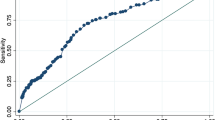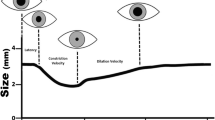Abstract
Pupillometry has been widely employed in the evaluation of a large number of pathological conditions, including intracranial pathology. The recent introduction of a portable, user-friendly, infrared pupillometer (ForSite, NeurOptics Inc., Irvine, CA) has enabled the accurate and reproducible measurement of several pupillary parameters, such as maximum and minimum apertures, constriction and dilation velocities, and latency period. It should be noted that various clinical conditions, especially neurological and ocular diseases, as well as numerous medications, may interfere with the measurements. Furthermore, a number of physiological parameters, such as the intensity of retinal illumination, the level of patient's alertness, the intensity of ambient light, as well as the time of day that the examination is performed may alter the obtained values. The potential implications of pupillometry in the clinical assessment of neurosurgical patients, including its complex relationship to intracranial pressure changes, mandate the undertaking of prospective clinical studies validating the clinical significance of this noninvasive, diagnostic modality.
Similar content being viewed by others
References
Lowenfeld IE. The Pupil: Anatomy, Physiology, and Clinical Applications, 1st ed. Ames: Iowa State University Press; 1993; pp. 273–286.
Wilson SAK. Ectopia pupilliae in certain mesencephalic lesions. Brain 1906;29:524–536.
Fisher CM. Oval pupils. Arch Neurol 1980;37(8):502–503.
Marshall LF, Barba D, Toole BM, Bowers SA. The oval pupil: clinical significance and relationship to intracranial hypertension. J Neurosurg 1983;58(4):566–568.
Taylor WR, Chen JW, Meltzer H, et al. Quantitative pupillometry, a new technology: normative data and preliminary observations in patients with acute head injury. Technical note. J Neurosurg 2003;98(1):205–213.
Morris GF, Juul N, Marshall SB, Benedict B, Marshall LF. Neurological deterioration as a potential alternative end-point in human clinical trials of experimental pharmacological agents for treatment of severe traumatic brain injuries. Neurosurgery 1998;43(6):1369–1374.
Chesnut RM, Gautille T, Blunt BA, Klauber MR, Marshall LE. The localizing value of asymmetry in pupillary size in severe head injury: relation to lesion type and location. Neurosurgery 1994; 34(5):840–845.
Choi SC, Narayan RK, Anderson RL, Ward JD. Enhanced specificity of prognosis in severe head injury. J Neurosurg 1988;69(3):381–385.
Litvan I, Saposnik G, Maurino J, et al. Pupillary diameter assessment: need for a graded scale. Neurology 2000;54(2):530–531.
Meeker M, Du R, Bacchetti P, et al. Pupil examination: validity and clinical utility of an automated pupillometer. J Neurosci Nurs 2005;37(1):34–40.
Boev AN, Fountas KN, Karampelas I, et al. Quantitative pupillometry: normative data in healthy pediatric volunteers. J Neurosurg 2005;103(6)Suppl:496–500.
Wachler BS, Krueger RR. Agreement and repeatability of infrared pupillometry and the comparison method. Ophthalmology 1999;106(2):319–323.
Larson MD, Muhiudeen I. Pupillometric analysis of the “absent light reflex”. Arch Neurol 1995;52(4):369–372.
Davies DR, Smith SE. Pupil abnormality in amyloidosis with autonomic neuropathy. J Neurol Neurosurg Psychiatry 1999;67(6):819–822.
Dütsch M, Hilz MJ, Rauhut U, Solomon J, Neundorfer B, Axelrod FB. Sympathetic and parasympathetic pupillary dysfunction in familial dysautonomia. J Neurol Sci 2002;195(1): 77–83.
de Seze J, Arndt C, Stojkovic T, et al. Pupillary disturbances in multiple sclerosis: correlation with MRI findings. J Neurol Sci 2001;188(1–2):37–41.
Bertinotti L, Pietrini U, Del Rosso A, et al. The use of pupillometry in joint and connective tissue diseases. Ann NY Acad Sci 2002;96(6):446–455.
Micieli G, Tassorelli C, Martignoni E, Marcheselli S, Rossi F, Nappi G. Further characterization of autonomic involvement in multiple system atrophy: a pupillometric study. Funct Neurol 1995;10(6):273–280.
Mylius V, Braune HJ, Schepelmann K. Dysfunction of the pupillary light reflex following migraine headache. Clin Auton Res 2003;13(1):16–21.
Lowenstein O, Loewenfeld IE. In: The Pupil in the Eye, Vol. 3, Davson H, ed. New York: Academic Press, 1969; pp. 269–270.
McLaren JW, Hauri PJ, Lin SC, Harris CD. Pupillometry in clinically sleepy patients. Sleep Med 2002;3(4):347–352.
Kraemer S, Danker-Hopfe H, Dorn H, Schmidt A, Ehlert I, Herrmann WM. Time-of-day variations of indicators of attention: performance, physiologic parameters, and self-assessment of sleepiness. Biol Psychiatry 2000;48(11):1069–1080.
Barr KJ, Boettger MK, Till S, Dolicek J, Sauer H. Lateralization of pupillary light reflex parameters. Clin Neurophysiol 2005;116:790–798.
Jones R. Do women and myopes have larger pupils? Invest Ophthalmol Vis Sci 1990;31(7):1413–1415.
Piha SJ, Halonen JI. Infrared pupillometry in the assessment of autonomic function. Diabetes Res Clin Pract 1994;26(1):61–66.
Larson MD, Berry PD. Supraspinal pupillary effects of intravenous and epidural fentanyl during isoflurane anesthesia. Reg Anesth Pain Med 2000;25(1):60–66.
Gray AT, Krejci ST, Larson MD. Neuromuscular blocking drugs do not alter the pupillary light reflex of anesthetized humans. Arch Neurol 1997;54(5):579–584.
Fliegart F, Kurth B, Gohler K. The effects of tramadol on static and dynamic pupillometry in healthy subjects—the relationship between pharmacodynamics, pharmacokinetics and CYP2D6 metaboliser status. Eur J Clin Pharmacol 2005;61(4): 257–266.
Fotiou F, Fountoulakis KN, Goulas A, Alexopoulos L, Palikaras A. Automated standardized Pupillometry with optical method for purposes of clinical practice and research. Clin Physiology 2000;20(5):336–347.
Lam BL, Thompson HS, Corbett JJ. The prevalence of simple anisocoria. Am J Ophthalmol 1987;104(1):69–73.
Manley GT, Larson MD. Infrared pupillometry during uncal herniation. J Neurosurg Anesthesiol 2002;14(3):223–228.
Author information
Authors and Affiliations
Corresponding author
Rights and permissions
About this article
Cite this article
Fountas, K.N., Kapsalaki, E.Z., Machinis, T.G. et al. Clinical implications of quantitative infrared pupillometry in neurosurgical patients. Neurocrit Care 5, 55–60 (2006). https://doi.org/10.1385/NCC:5:1:55
Issue Date:
DOI: https://doi.org/10.1385/NCC:5:1:55




